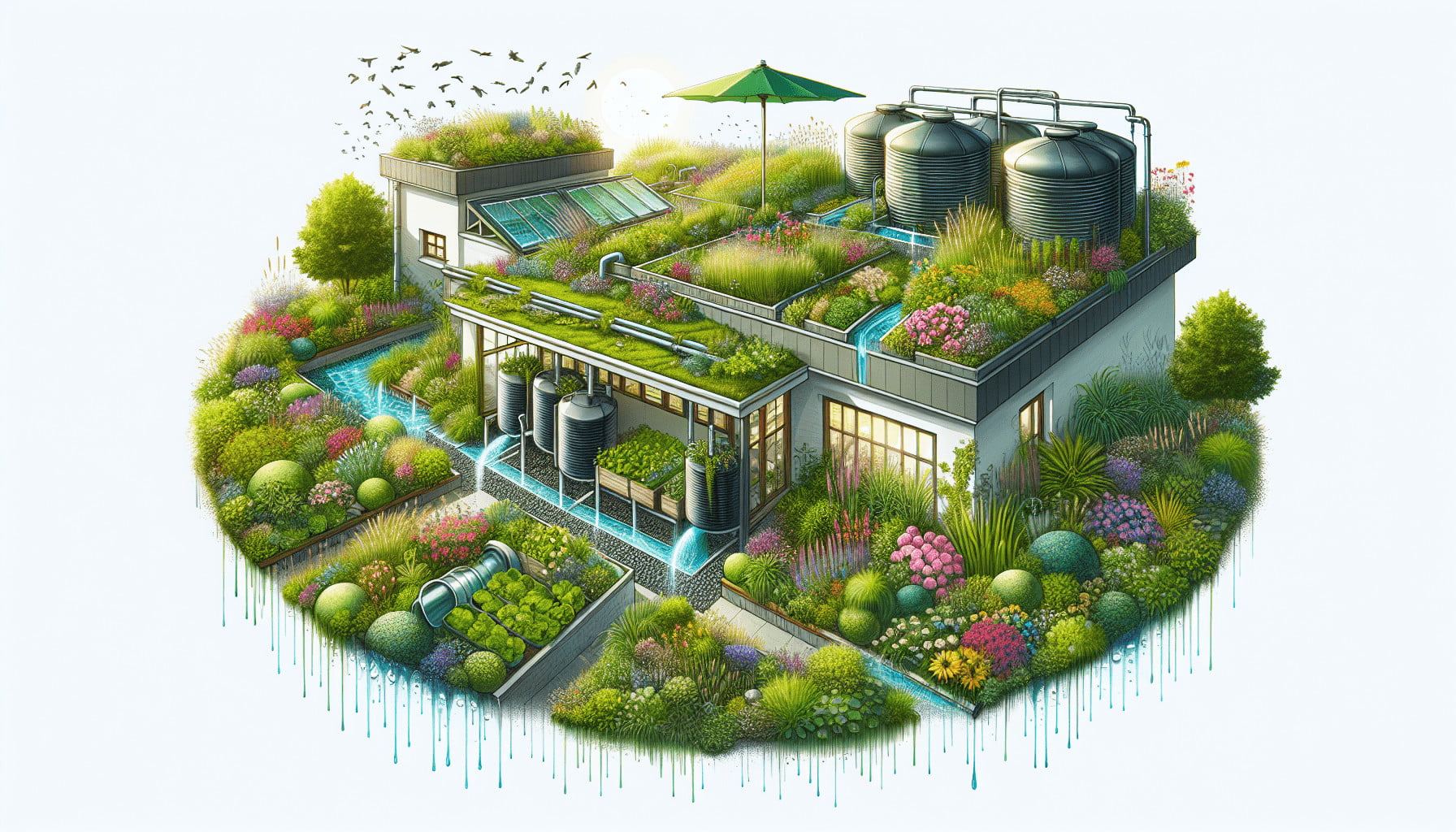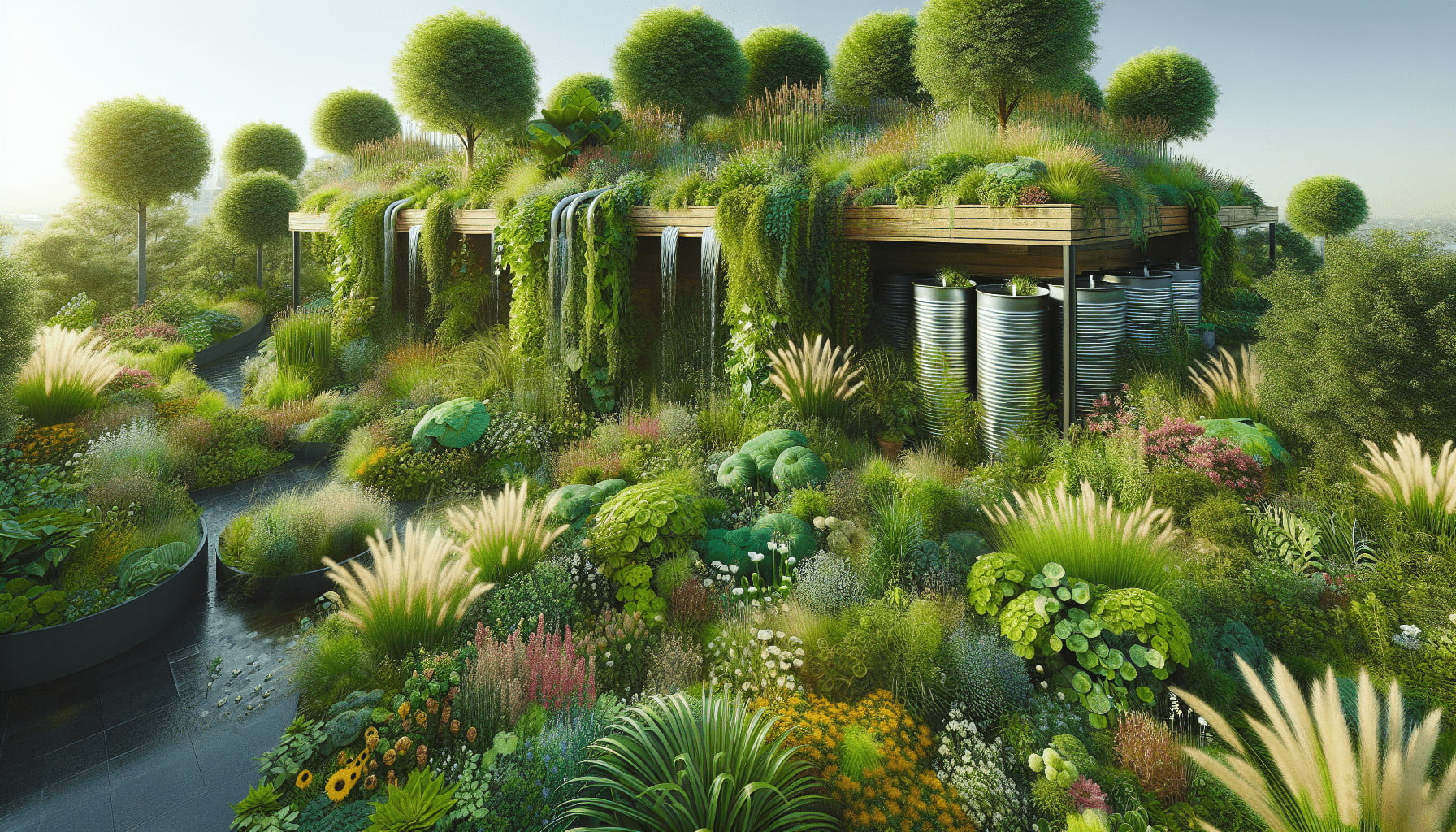You’re about to delve into a comprehensive guide on how to make the most out of rainwater harvesting within green roof systems. This article covers the top methods for integrating rainwater collection with green roofs, ensuring you not only maximize the environmental benefits but also enhance the overall efficiency of your building’s water management system.
Installing a green roof is already a fantastic step towards creating a more sustainable environment, but adding rainwater harvesting to the mix can take it to the next level.
Let’s dive into the best ways to utilize rainwater harvesting in green roof systems, ensuring you get the most out of your eco-friendly investment.
Understanding Rainwater Harvesting
Before you reap the benefits of rainwater harvesting, it’s important to grasp the basics. At its core, rainwater harvesting involves collecting and storing rainwater for later use. This can be done on a small scale, such as with a simple rain barrel, or on a larger scale with sophisticated systems that involve tanks, filtration, and pumps.
Basic Components of Rainwater Harvesting Systems
Here are the fundamental components you’ll typically find in a rainwater harvesting system:
| Component | Description |
|---|---|
| Catchment Area | The surface that collects the rainwater, often rooftops for green roof systems. |
| Gutters and Downspouts | Directs water from the catchment area to storage. |
| First Flush Diverter | Diverts the initial runoff, which may contain debris and contaminants, away from the storage tank. |
| Storage Tank | The container where the harvested rainwater is stored, either above or below ground. |
| Filtration System | Ensures the cleanliness of stored water by removing debris and contaminants. |
| Distribution System | Pipes and pumps that deliver stored water to where it’s needed. |
Benefits of Rainwater Harvesting with Green Roofs
Combining rainwater harvesting with green roofs offers numerous benefits that go beyond just sustainability. From reducing water costs to supporting plant growth, the advantages are manifold.
Environmental Benefits
Integrating rainwater harvesting with a green roof plays a significant role in environmental stewardship. Not only does it reduce reliance on municipal water sources, but it also helps mitigate urban heat islands and manage stormwater runoff. By reducing runoff, you decrease the risk of flooding and erosion, contributing to healthier waterways.
Economic Benefits
You might be surprised to find out that rainwater harvesting can also save you money. By using stored rainwater for irrigation and other non-potable purposes, you can cut down on your water bills. Additionally, some municipalities offer rebates or incentives for installing rainwater harvesting systems, making it a financially attractive option.
Enhanced Plant Health
Rainwater is free of the chemicals found in municipal water supplies, making it ideal for your green roof plants. The absence of chlorine and fluoride in rainwater ensures that plants receive more natural nourishment, leading to healthier growth and more vibrant foliage.

Steps to Implement Rainwater Harvesting in Your Green Roof
Now that you’re convinced of the benefits, let’s explore the steps to effectively implement a rainwater harvesting system in your green roof.
Planning and Design
Effective rainwater harvesting begins with a well-thought-out plan. You’ll need to assess your rooftop area, potential water catchment, and storage requirements. Consulting a professional for a detailed design proposal can be extremely beneficial.
Selecting the Right System
Different systems are suitable for different scales and types of green roofs. Here are some options:
| System Type | Best For |
|---|---|
| Simple Rain Barrels | Small-scale projects with limited budget |
| Intermediate Systems | Medium-sized rooftops needing moderate water storage |
| Advanced Systems | Large-scale or commercial rooftops that require sophisticated storage and distribution |
Installation
Once you’ve selected the appropriate system, it’s time for installation. Although DIY options are available for simpler systems, professional installation ensures that everything is set up correctly and efficiently. Proper installation is key to maximizing the benefits of rainwater harvesting and avoiding potential issues down the road.
Maintenance
Maintenance is a crucial aspect of any rainwater harvesting system. Regularly cleaning gutters, checking filters, and inspecting storage tanks will ensure your system runs smoothly. Regular maintenance helps in prolonging the life of your system and optimizing its performance.
Best Practices for Maximizing Efficiency
Just like any system, efficiency matters when it comes to rainwater harvesting. Here are some best practices to follow:
Optimal Rooftop Design
The design of your green roof plays a significant role in rainwater collection. Ensuring an even slope can enhance water capture efficiency. Incorporate a variety of plant species that can thrive with the amount of water you’re able to collect and store.
Water Conservation Practices
Implement water conservation practices to make the most of your harvested rainwater. Using drip irrigation systems and moisture sensors can help you use water more efficiently. Educating yourself on when and how much to water your plants can make a big difference in conservation.

Solutions for Common Challenges
While rainwater harvesting offers numerous benefits, it’s not without its challenges. Understanding and addressing these can help you make the most of your system.
Overcoming Space Constraints
If you have limited space for storage tanks, consider modular or stackable tank systems. Alternatively, underground storage can be a space-saving solution, though it may come with higher installation costs.
Dealing with Variability in Rainfall
In areas with inconsistent rainfall, consider integrating your rainwater harvesting system with municipal water to ensure a steady supply. Utilizing smart controls and sensors can help manage the switch between stored rainwater and municipal sources efficiently.
Ensuring Water Quality
Maintaining high water quality is crucial, especially if you plan on using harvested rainwater for more than just irrigation. Regularly cleaning and maintaining your system’s components will go a long way in ensuring that the water you store is clean and usable.
Legal and Regulatory Considerations
Rainwater harvesting regulations can vary significantly depending on your location. It’s important to understand the legal landscape before setting up your system.
Local Regulations
Some regions have strict regulations around rainwater harvesting, including permits and design requirements. Check with local authorities to ensure compliance with all relevant laws.
Potential Incentives
Many municipalities offer incentives or rebates for installing rainwater harvesting systems. These can include financial subsidies or tax benefits, making it even more appealing to implement such systems.
Real-World Examples
Sometimes, seeing how others have successfully integrated rainwater harvesting with green roofs can provide valuable insights and inspiration.
Case Study: Eco-Friendly Office Building
In a bustling urban area, an office building integrated a green roof with an advanced rainwater harvesting system. This project not only reduced the building’s water usage by 40% but also made the office a more pleasant place for employees, contributing to higher productivity and reduced urban heat island effect.
Case Study: Residential Rooftop Garden
A homeowner decided to turn their flat roof into a lush garden, supplemented by a simple rainwater harvesting system. Over a year, they managed to cut their water bill by half and created an inviting space that doubled as an urban oasis.
Future Trends in Rainwater Harvesting and Green Roofs
As sustainability continues to gain importance, the integration of rainwater harvesting systems and green roofs is expected to grow. Emerging technologies promise even more efficient and cost-effective solutions.
IoT Integration
The Internet of Things (IoT) is set to play a significant role in the future of rainwater harvesting. Smart sensors and automation can optimize water collection, storage, and usage, making systems more efficient and user-friendly.
New Materials and Designs
Innovations in materials and design are making green roofs and rainwater harvesting systems more effective and easier to install. Lightweight substrates and modular green roof solutions are just a few examples.
Conclusion
So there you have it—the best ways to utilize rainwater harvesting in your green roof systems. By understanding the basics, carefully planning your system, and following best practices, you can maximize the benefits of your eco-friendly project. Whether you’re looking to cut water costs, enhance plant health, or contribute to a more sustainable environment, integrating rainwater harvesting with your green roof is a winning move. Happy harvesting!
